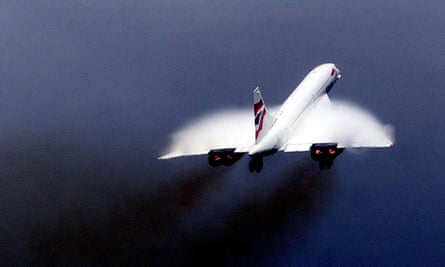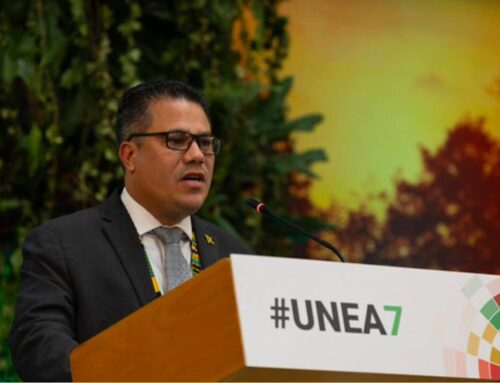‘As an environmental scientist, I’m horrified’: Should supersonic passenger travel be maki
April 12, 2025
When I call Blake Scholl from New York, he says it’s a shame we couldn’t have met at his office in Colorado. If only there were a supersonic jet that could cruise at 1.7 times the speed of sound, and get me there two hours quicker than the typical JFK-to-Denver route.
There soon might be. Scholl is the CEO of Boom Supersonic, a company betting that ordinary civilians want to shoot across the sky at 1,100 miles (1,700 kilometres) per hour. After the pandemic brought a slump to the skies, air travel has returned to its former levels, and in-person business events are back on track. As a faster option for these travellers, Boom is developing its breakneck jets to be operational by 2029 – nearly a quarter century after Concorde landed its last plane.
Aside from keeping the slender, pointed design, Boom distances itself from Concorde, which Scholl calls “a false start” to a supersonic age. In Boom’s revived version, its 64-seater airliners could whizz across the Atlantic in three-and-a-half hours, at least twice as fast as commercial carriers, and check off hundreds of new routes such as Madrid to Miami, or Tokyo to Seattle. They would lean into software and algorithms to tweak speed and altitude based on real-time conditions. Boom is already “a darling of the bros at Silicon Valley,” says Brian Foley, a US-based aviation industry analyst and former aerospace engineer, pointing to investors including OpenAI’s Sam Altman.
But sceptics will compare Boom to Concorde, and question whether it can overcome the list of issues that led to its predecessor’s decline, including price, demand, safety, regulation and the environment – all of which may remain stubborn barriers.
To its credit, Boom has appeared to solve one of Concorde’s major hurdles: the sonic boom, the ear-splitting thunderclap heard on the ground when an object travels through the air faster than the speed of sound. When an aeroplane moves, molecules ahead have to get out of the way; as it breaks the sound barrier, the craft catches up and drags the molecules along with it. The sudden disruption causes a shock wave, felt as a deafening roar.
Concorde couldn’t escape the boom as it flew at Mach 2, or twice the speed of sound. “When they got it wrong, it was smashing greenhouses and scaring little old ladies,” says Guy Gratton, associate professor of aviation and the environment at Cranfield University in Bedfordshire. The sheer sound forced noise regulations in Europe, and in the US an outright ban on supersonic flight in 1973, relegating Concorde to oceanic routes such as London to New York.
That isn’t enough for Boom, which wants to capture the domestic business market and fly above land at Mach 1.7. So, in quite the physics feat, Boom has eliminated the sonic boom.
It has put into practice a longstanding theory of refraction known as “Mach cutoff”, which works via the same law that makes a pencil appear to bend in a glass of water in the classic school lab experiment. As the plane flies, the sound wave refracts towards colder temperatures, curling upwards. It keeps turning upwards until it reaches space.

During two supersonic test flights in January and February, with a specially built craft a third of the proposed size, Boom demonstrated the Mach cutoff six times, without an audible boom on each occasion.
Boom’s planned aircraft, Overture, is still in early development and will be a different beast, especially because Boom is making its own engine. That’s rare in an industry where commercial craft invariably use engines from the established giants such as General Electric and Rolls-Royce. “I’m not convinced the current team assembled has the experience or depth or capability to develop a supersonic engine,” Foley says.
If they can do it, their timing is opportune. The first American-built civilian supersonic jet is likely to be welcomed by a protectionist federal administration gung-ho on US manufacture and deregulation. In the Oval Office in February, Donald Trump posed with an Overture model, and Elon Musk pledged to overturn the supersonic ban. The $600m infusion of funding from some of his billionaire peers won’t hurt.
Boom isn’t the only company developing a “quiet” supersonic aircraft. Nasa is testing its own experimental X-59 jet. And an aircraft from China’s state-owned manufacturer Comac is reportedly under way, according to a self-released paper. A patriotic aerospace race could further spur legislation. “Let’s beat ’em,” Scholl posted on X, with a US flag emoji.
But success will ultimately depend on consumer demand. The tragic crash in 2000 of an Air France Concorde catalysed its downfall, which was compounded by the downturn in air travel after 9/11. It’s unclear whether the public wants supersonic travel – or even knows of its existence. The only surveys that exist are Boom’s own (which unsurprisingly claim that 97% of passengers want it); two major aviation research firms told me there’s no real data.
Demand will be driven by affordability. “Concorde was for royalty and rock stars,” Scholl says of its $20,000 tickets in today’s money. He estimates Boom could start at $5,000 for a transatlantic flight, akin to some business-class fares. But at a time of inflation, it’s not cheap. Despite Scholl’s vision for our in-person meeting, freelance journalists are not the target market, though he says he predicts economy-level fares “for the rest of us” by the late 2030s.
Foley isn’t swayed. “This isn’t a ‘scale big’ aerospace segment,” he says. “It’s a very niche market.” Major carriers such as American and United have already put in orders for aircraft, but Foley says that’s a typical PR move for carriers to show their progressiveness. Eventually, they’ll cave to pure cost-per-seat-mile economics. The private jet market may be a better fit, but even with their participation, Foley estimates Boom would probably only sell about 300 aircraft over 10 years.
The private jet sector is routinely under fire for its poor environmental record, burning far more fuel per passenger mile. And while aviation in general accounts for 2.5% of all emissions, the industry continues to grow, leading to predictions it will double its carbon output by 2050.
Scholl says Overture will be built to be compatible with sustainable aviation fuel, and that choosing between innovative tech and the environment is a “mistaken trade-off”. The public may have different ideas. Even in the 1960s, Concorde faced eco-pushback around emerging ozone layer concerns, and advocacy from grassroots campaigns such as the Citizens League Against the Sonic Boom helped secure the bans.
Today, Gratton says it’s “irresponsible” for a supersonic jet that burns two to three times more fuel to be launched in a full-fledged climate crisis. “As an aeronautical engineer, I am absolutely thrilled with what Boom are doing,” he says. “As an environmental scientist, I’m horrified.”
“They are doing very clever work,” Gratton says. “Whether it’s a good idea that they do it – that’s the tougher question.”
Search
RECENT PRESS RELEASES
Related Post



